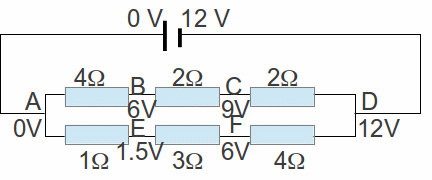In a simple electric circuit where every device is in series or parallel with every other devoice in an easily identifiable way it is often quite simple to find the potential difference between any two point.
We can use the simple facts that for resistors in series the voltage splits across each component in proportional to the resistances, while the voltage across each parallel circuit is the same.

Across the upper part of the parallel circuit above – the resistors![]() and
and![]() – the voltage splits in the ratio
– the voltage splits in the ratio![]() or 6:3:3.
or 6:3:3.
The voltage at A is 0V so the voltage at B is 6V, the voltage at C is 6+3=9V and the voltage at D is 12 V (D is directly connected to the positive terminal).
Across the lower part of the parallel circuit above – the resistors![]() and
and![]() – the voltage splits in the ratio
– the voltage splits in the ratio![]() or 1.5:4.5:6.
or 1.5:4.5:6.
The voltage at A is 0V so the voltage at E is 1.5V, the voltage at F is 1.5+4.5=6V and the voltage at D is 12 V as before. The voltages at each point are shown below.
 >
>
The potential difference between B and E is 6-1.5=4.5V.
The potential difference between C and F is 6-1.5=4.5V.
Other potential differences can be found as simply.
